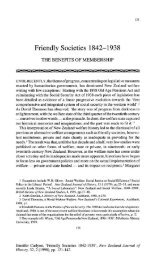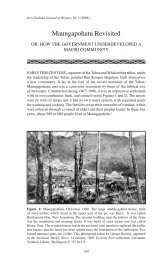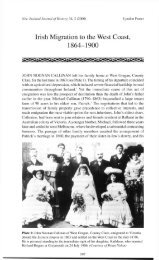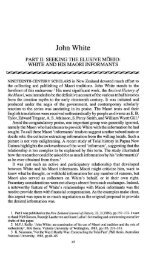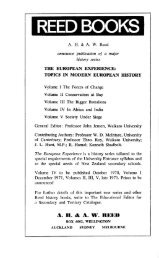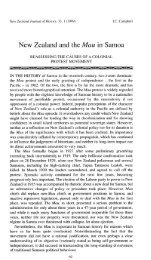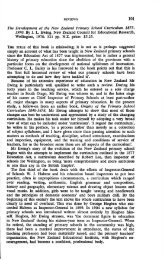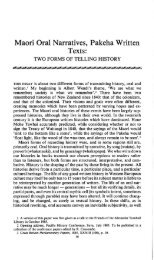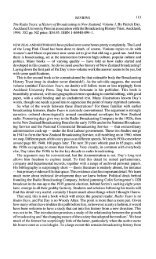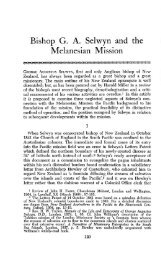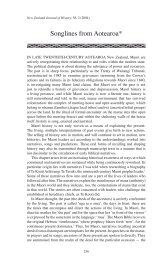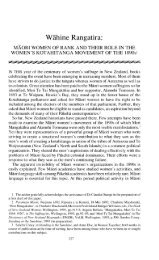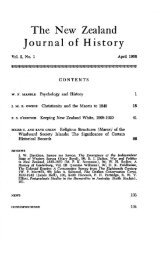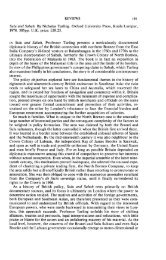Songlines from Aotearoa* - New Zealand Journal of History
Songlines from Aotearoa* - New Zealand Journal of History
Songlines from Aotearoa* - New Zealand Journal of History
You also want an ePaper? Increase the reach of your titles
YUMPU automatically turns print PDFs into web optimized ePapers that Google loves.
SONGLINES FROM AOTEAROA 263<br />
This narrative implicitly identifies Rua with Tawhaki, who had travelled to<br />
heaven to meet Whaitiri. On his journey, Tawhaki entered one <strong>of</strong> the meeting<br />
houses <strong>of</strong> Ngahui Whatu, and there identified and recovered his father’s bones.<br />
Ngahui Whatu are the whatu kura, precious stones, who are the gathering<br />
<strong>of</strong> the stars, and the ancestors to whom Tawhaki prays. 29 The first karakia<br />
Tawhaki had been taught by Tama-i-waho in the highest heaven, to fix his new<br />
knowledge was Te Whatu, the Stone, and it is commonly said that Tawhaki<br />
brought back the first ‘whatu kura’ to humankind. 30 Whatu kura were used in<br />
the East Coast schools <strong>of</strong> learning to seal the scholars’ knowledge, and the tiny<br />
stones they had to search for, and swallow, were usually coloured red or white.<br />
On Wharekauri, in 1868, Te Kooti set the prisoners a riddle to resolve before<br />
their escape: how to eat a small white stone that he said had been revealed to<br />
him. The solution, to pound the stone and share it, bonded the prisoners and<br />
sealed their grasp <strong>of</strong> the escape plan.<br />
Diamonds, like the one revealed on Maungapohatu, are precious stones not<br />
found naturally in <strong>New</strong> <strong>Zealand</strong>. The story has several imaginative sources:<br />
one was quite possibly the North American Indian legend <strong>of</strong> the diamond<br />
hidden in their land, which had been retold by Nathaniel Hawthorne in 1851 as<br />
‘The Great Carbuncle’, and then widely circulated; another, I suggest, was the<br />
narrative <strong>of</strong> Tawhaki, who had encountered the whatu kura. In a version <strong>from</strong><br />
inland Poverty Bay, the Ringatu elder Ned Brown told the story <strong>of</strong> the portion<br />
<strong>of</strong> Te Kooti’s diamond, which Ned’s ancestor, Te Hira Uetuku, who had been<br />
a prisoner on Wharekauri, brought to his trib-al mountain, Maungahaumi, as<br />
a gift <strong>from</strong> Te Kooti. This was the mauri, the local guardian stone for the land<br />
and its people. In this version, Te Kooti’s diamond was shaped like the Lamb<br />
<strong>of</strong> God, ‘Te Reme’, and their portion was its foot (waewae), thus preserving<br />
their turangawaewae (footing). Ned then went on implicitly to connect the<br />
diamond with the large, glittering quartz-stone that used to be visible when<br />
the sun shone on the Mangatu River, whose several sources flow down <strong>from</strong><br />
Maungahaumi. The stone disappeared ‘when the Europeans started the wars’,<br />
but little white quartz pebbles, called the ‘children <strong>of</strong> Mangatu’, still tumbled<br />
in the river when it was clear — before the land was deforested and the river<br />
began to flood uncontrollably. 31 The little ‘glittering’ stones were like the stars<br />
<strong>of</strong> the Tama stream, and they existed before the environment was damaged<br />
by ‘prominent men’. This narrative <strong>of</strong> the river tells how ‘it once was’, and<br />
suggests also how ‘it should be’. The story is part <strong>of</strong> a system <strong>of</strong> knowledge<br />
that is particular and local, but which carries warnings <strong>of</strong> the dangers created<br />
through ignorance, corruption and greed.<br />
The story <strong>of</strong> Te Kooti’s diamond, hidden on the sacred mountains <strong>of</strong> each<br />
<strong>of</strong> the tribes who had sheltered him during the colonial wars, was given new<br />
life by Rua in 1905. In January <strong>of</strong> that year, the largest diamond in the world,<br />
the Cullinan diamond, was discovered in South Africa. The Boers called it<br />
‘God’s stone’, and after much public discussion, the parliament <strong>of</strong> the recently<br />
defeated Transvaal Republic voted, in 1907, to give it to King Edward VII<br />
as a state-ment <strong>of</strong> their loyalty. Rua, a regular reader <strong>of</strong> the Auckland Weekly<br />
<strong>New</strong>s, a popular photographic magazine, and who later papered the walls <strong>of</strong> his<br />
home and surrounding buildings at Maai with its pages, pre-empted the Boers



